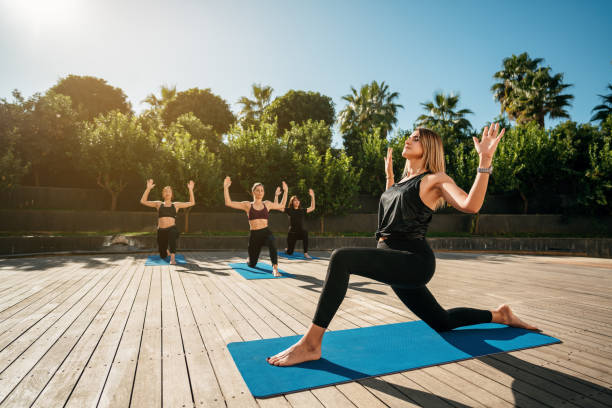In the hustle and bustle of daily life, it’s easy to get caught up in the rush and overlook the importance of mindful movement. But what if I told you that the way you move can have a profound impact on your overall well-being?
Mindful movement is about more than just going through the motions – it’s about cultivating a deeper connection between your body, mind, and spirit, and experiencing the present moment with awareness and intention.
What Exactly is Mindful Movement?
Mindful movement is a practice rooted in mindfulness, a state of non-judgmental awareness of the present moment. It involves bringing conscious attention to the sensations, thoughts, and emotions that arise as you engage in physical activity, whether it’s yoga, tai chi, qigong, walking, or even everyday tasks like washing dishes or gardening.
The goal of mindful movement is not to achieve a particular outcome or goal, but rather to cultivate a sense of presence, acceptance, and self-awareness in each moment. By approaching movement with curiosity, openness, and compassion, we can tap into the innate wisdom of our bodies and deepen our connection to ourselves and the world around us.
Benefits of Mindful Movement
The benefits of mindful movement extend far beyond the physical realm. Here are some of the ways in which it can enhance your overall well-being:
1. Stress Reduction
Mindful movement can help reduce stress by activating the body’s relaxation response, lowering levels of stress hormones such as cortisol, and promoting a sense of calm and relaxation.
2. Improved Mental Clarity
Engaging in mindful movement can enhance mental clarity, focus, and concentration by quieting the chatter of the mind and bringing attention to the present moment.
3. Enhanced Emotional Regulation
By cultivating awareness of the mind-body connection, mindful movement can help regulate emotions, reduce reactivity, and promote greater emotional resilience and balance.
4. Increased Body Awareness
Mindful movement encourages greater awareness of bodily sensations, posture, and alignment, helping to improve body awareness and prevent injury.
Engaging in mindful movement can foster a deeper connection to oneself, others, and the world around us, promoting a sense of interconnectedness and belonging.
Tips for Practicing Mindful Movement
Ready to incorporate mindful movement into your daily routine? Here are some practical tips to help you get started:
1. Start Small
You don’t need to set aside hours for mindful movement – even just a few minutes a day can make a difference. Start by incorporating short mindfulness practices into your daily activities, such as taking a mindful walk during your lunch break or doing a brief yoga sequence in the morning.
2. Tune Into Your Body
Pay attention to the sensations, thoughts, and emotions that arise as you move. Notice the feeling of your feet connecting with the ground, the rhythm of your breath, and any areas of tension or discomfort in your body. Allow yourself to move with ease and fluidity, honoring your body’s unique needs and limitations.
3. Cultivate Presence
Bring your full attention to the present moment, letting go of distractions and worries about the past or future. Focus on the task at hand, whether it’s stretching, walking, or dancing, and allow yourself to experience each moment fully, without judgment or attachment.
4. Practice Acceptance
Approach mindful movement with an attitude of acceptance and self-compassion. Be gentle with yourself and let go of any expectations or judgments about how you should look or feel. Embrace the present moment as it is, acknowledging and accepting whatever arises with kindness and curiosity.
5. Stay Curious
Approach mindful movement with a sense of curiosity and exploration. Experiment with different forms of movement, such as yoga, tai chi, or dance, and notice how each practice makes you feel. Allow yourself to be open to new experiences and insights, and trust in the wisdom of your body to guide you on your journey.
The Different Types of Mindful Movement
Incorporating mindful movement into your life offers significant benefits, akin to preventive medicine for both body and mind. Are you eager to begin? Here are five types of mindful movement to explore:
1. Mindful Walking
Engage in the simplest form of mindful movement – walking. Practice mindfulness of the senses as you walk, noticing what you see, hear, touch, smell, and taste. Feel the earth beneath your feet, expressing gratitude for each step.
2. Qigong
Explore the ancient practice of qigong, focusing on specific physical or mental concerns through gentle, flowing movements. Emphasize the unity of breath and body, harnessing life energy to restore vitality.
3. Tai Chi
Discover the graceful martial art of tai chi, characterized by a sequence of flowing, dance-like movements. Pay attention to the breath-body connection and focus on precise form, fostering harmony and balance.
4. Interpretive Dance
Experience the liberating practice of interpretive dance, allowing your body to move freely to the rhythm of your spirit. Whether athletic or soothing, let your internal rhythms guide your expression.
5. Yoga
Delve into the ancient practice of yoga, offering a variety of styles to suit every individual. From meditative yin to dynamic power yoga, explore the diverse world of yoga and find a practice that resonates with you.
Mindful movement is a powerful practice that can transform the way you move, think, and live. By incorporating mindfulness into your physical activities, you can cultivate a deeper connection to yourself and the world around you, enhance your overall well-being, and live with greater presence, purpose, and joy.
